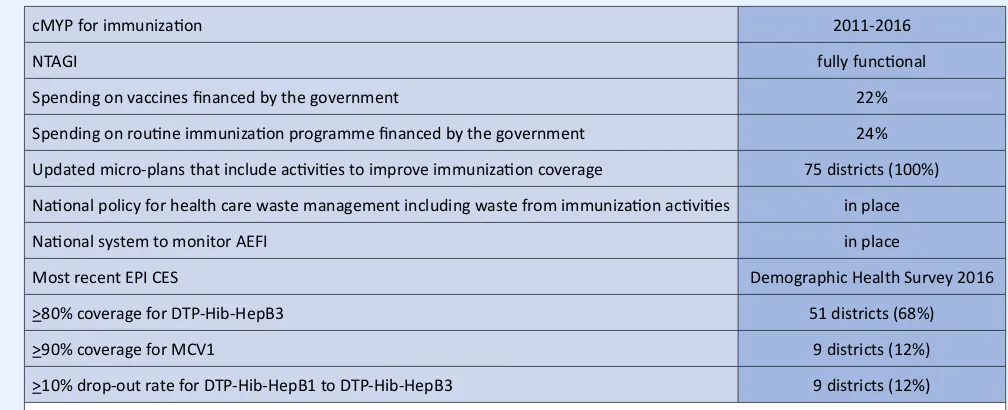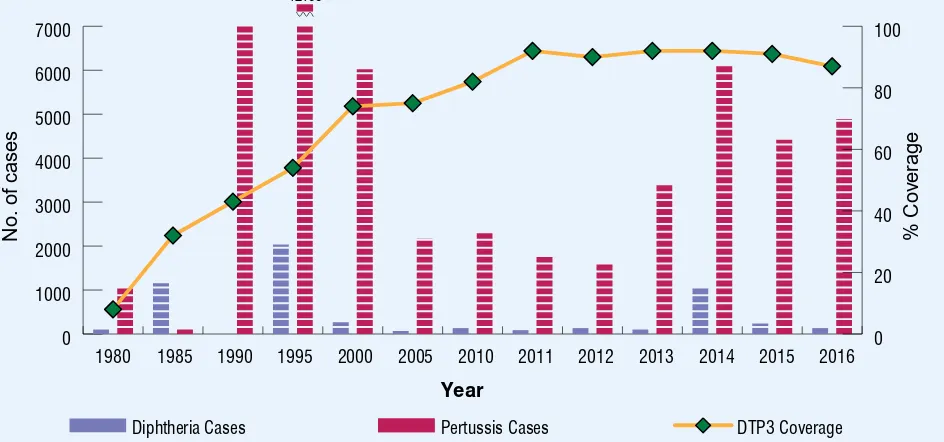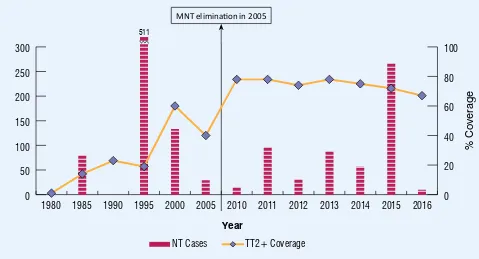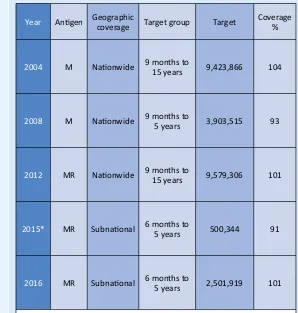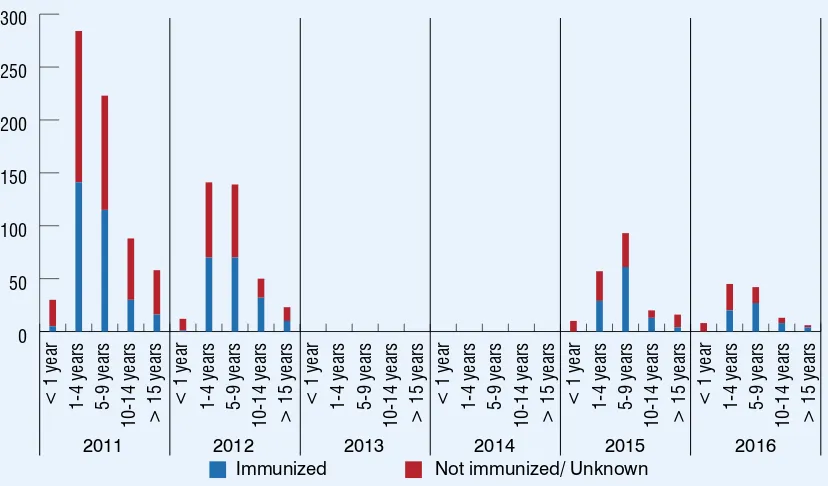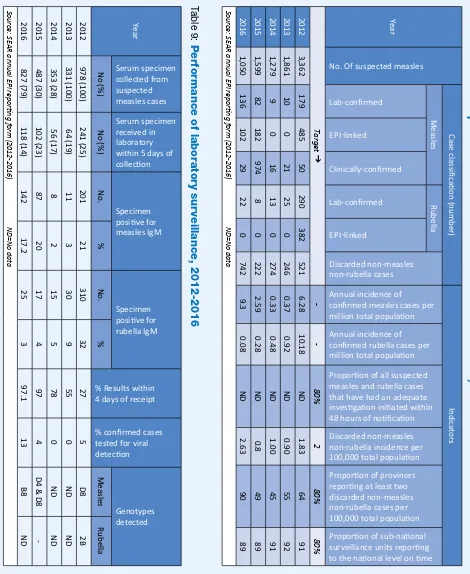Nepal 2017
Acronyms
AD Auto disable
AEFI Adverse events following immunization
AFP Acute flaccid paralysis
BCG Bacillus Calmette-Guérin vaccine
CES Coverage evaluation survey
cMYP Comprehensive multi-year plan
CRS Congenital rubella syndrome
DHS Demographic health survey
DT Diphtheria tetanus toxoid, pediatric
DTP Diphtheria – tetanus – pertussis vaccine
DTP-Hib-HepB Pentavalent vaccine
DTP-Hib-HepB3 3rd dose pentavalent vaccine
EPI Expanded programme on immunization
GDP Gross domestic product
HCW Health care worker
HepB Hepatitis B vaccine
Hib Haemophilus influenzae type b
HPV Human papilloma virus
IgM Immunoglobulin M
IPV Inactivated poliovirus vaccine
JE Japanese encephalitis
JE_Live-Atd JE live attenuated vaccine
JRF WHO UNICEF joint reporting form
LB Live birth
M Measles
MCV1 First dose measles containing vaccine
MCV2 Second dose measles containing vaccine
MICS Multiple indicator cluster survey
MMR Measles mumps rubella vaccine
MNT Maternal and neonatal tetanus
MR Measles rubella vaccine
NCIP National committee on immunization practices
NID National immunization day
NTAGI National technical advisory group on immunization
NPEV Non-polio enterovirus
NT Neonatal tetanus
OPV Oral poliovirus vaccine
bOPV Bivalent OPV
tOPV Trivalent OPV
PCV Pneumococcal conjugate vaccine
SEAR WHO South-East Asia Region
SIA Supplementary immunization activities
SNID Subnational immunization day
Td Tetanus diphtheria toxoid; older children, adults
TT Tetanus toxoid
TT2+ 2 or more doses TT
VDPV Vaccine derived poliovirus
VPD Vaccine preventable diseases
WCBA Women of child bearing age
Contents
Impact of rou�ne immuniza�on
Page
No.
EPI history 5
Basic informaion 2016 Table 1 5
Immunizaion schedule 2016 Table 2 5
Naional immunizaion coverage 1980 - 2016 Figure 1 6
Immunizaion system highlights Table 3 6
DTP3 coverage, diphtheria and pertussis cases 1980 - 2016 Figure 2 7 Reported cases of vaccine preventable diseases 2011 - 2016 Table 4 7
DTP-Hib-HepB3 coverage by district 2015 Figure 3 7
DTP-Hib-HepB3 coverage by district 2016 Figure 4 7
Towards measles elimina�on and rubella/congenital rubella
syndrome control
Page
No.
MCV1 and MCV2 coverage, measles and rubella cases, 1980-2016 Figure 10 11
MCV supplementary immunizaion aciviies Table 7 11
MCV1 coverage by district 2015 Figure 11 12
MCV1 coverage by district 2016 Figure 12 12
MCV1 coverage by district 2016 Figure 13 12
Immunity against measles – immunity proile by age in 2016 Figure 14 12 Subnaional risk assessment for measles and rubella Figure 15 12 Sporadic and outbreak associated measles cases by month 2011 - 2016 Figure 16 13 Immunizaion status of conirmed (laboratory and Epi linked) measles outbreak
associated cases by age 2011 – 2016 Figure 17 13
Quality of ield and laboratory surveillance for measles and rubella 2012 - 2016 Table 8 14 Performance of laboratory surveillance 2012 - 2016 Table 9 14 Network of WHO supported surveillance medical oicers and laboratories for
VPD surveillance Figure 18 15
Maternal and neonatal tetanus elimina�on is sustained
Page
No.
TT2+ coverage and NT cases 1980 - 2016 Figure 5 8
Polio-free status is maintained
Page
No.
AFP surveillance indicators 2011 - 2016 Table 5 9
Non-polio AFP rate by district 2015 Figure 6 9
Non-polio AFP rate by district 2016 Figure 7 9
Adequate stool specimen collecion percentage by district 2015 Figure 8 10 Adequate stool specimen collecion percentage by district 2016 Figure 9 10
WHO South-East Asia Region
EPI history
• EPI launched in 1979
• HepB vaccine introduced in 2002 • AD syringes introduced in 2003 • MCV SIA in 2004
• DTP-HepB vaccine introduced in 2005 • JE introduced in 2011
• DTP-Hib-HepB vaccine introduced in 2009
• MR vaccine introduced in 2013 • IPV vaccine introduced in 2014
• MR second dose introduced in late 2015 • PCV vaccine introduced in 2015
• tOPV to bOPV switched on 17 April 2016 • HPV demonstra�on project in
2 districts targe�ng school going girls of grade 6 and out of school girls of the age 11 years.
Source: cMYP 2011-2016 and EPI/MOH
Table 1:
Basic information
12016
Total populaion 28,624,299
Live births 637,263
Children <1 year 660,629
Children <5 years 2,959,177
Children <15 years 8,676,336
Pregnant women 751,490
WCBA (15-49 years) 8,202,399
Neonatal mortality rate 22.2 (per 1,000 LB)
Infant mortality rate 29.4 (per 1,000 LB)
Under-ive mortality rate 35.8 (per 1,000 LB)
Maternal mortality raio 258 (per 100,000 LB)
1SEAR annual EPI reporing form, 2016 and WHO, World Health Staisics, 2016
Division/Province/State/Region 5
District 75
Municipality 191
Village development commitee 3,639
Ward 35,163
Populaion density (per sq. km) 181
Populaion living in urban areas 18% Populaion using improved drinking-water
sources 88%
Populaion using improved sanitaion 37%
Total expenditure on health as % of GDP 5.5%
Births atended by skilled health personnel 36%
Neonates protected at birth against NT 82%
Table 2:
Immunization schedule, 2016
Vaccine Age of administraion
BCG Birth
DTP-Hib-HepB 6 weeks, 10 weeks and 14 weeks OPV 6 weeks, 10 weeks and 14 weeks
IPV 14 weeks
PCV 6 weeks, 10 weeks and 9 months
MR 9 months and 15 months
JE_LiveAtd 1 year
Td First contact in pregnancy and +1 month Vitamin A 6 months to 5 years and +6 months Source: WHO/UNICEF JRF, 2016
Table 3:
Immunization system highlights
cMYP for immunizaion 2011-2016
NTAGI fully funcional
Spending on vaccines inanced by the government 22%
Spending on rouine immunizaion programme inanced by the government 24%
Updated micro-plans that include aciviies to improve immunizaion coverage 75 districts (100%) Naional policy for health care waste management including waste from immunizaion aciviies in place
Naional system to monitor AEFI in place
Most recent EPI CES Demographic Health Survey 2016
>80% coverage for DTP-Hib-HepB3 51 districts (68%)
>90% coverage for MCV1 9 districts (12%)
>10% drop-out rate for DTP-Hib-HepB1 to DTP-Hib-HepB3 9 districts (12%)
Source: WHO/UNICEF JRF, 2016
Figure 1:
National immunization coverage, 1980-2016
% Coverage
Source: WHO/UNICEF esimates of naional immunizaion coverage, July 2017 revision
1980 1985 1990 1995 2000 2005 2010 2014 2015 2016
BCG 22 67 74 76 84 87 94 99 94 93
DTP3 8 32 43 54 74 75 82 92 91 87
OPV 20 42 50 74 78 83 92 90 85
MCV1 34 57 56 71 74 86 88 85 83
<70% 70% - 79% 80% - 89% >90%
Figure 3:
2015
Figure 4:
2016
Source: SEAR annual EPI reporing form, 2016 (administraive data) Source: SEAR annual EPI reporing form, 2015 (administraive data)
Figure 2:
DTP3 coverage
1, diphtheria and pertussis cases
2, 1980-2016
Year
Diphtheria Cases Pertussis Cases DTP3 Coverage
%
1WHO/UNICEF esimates of naional immunizaion coverage, July 2017 revision 2WHO vaccine-preventable diseases: monitoring system 2016
Table 4:
Reported cases of vaccine preventable diseases, 2011-2016
Year Polio Diphtheria Pertussis NT
(% of all tetanus) Measles Rubella Mumps JE CRS
2011 0 94 1,733 95 (49%) 2,359 1,175 39,023 129 ND
2012 0 138 1,595 32 (9%) 3,362 801 35,874 75 ND
2013 0 103 3,431 87 (23%) 1,861 755 29,134 118 ND
2014 0 1,079 6,096 57 (6%) 1,279 704 34,034 1,304 16
2015 0 236 4,416 266 (30%) 1,599 626 38,858 937 50
2016 0 140 4,890 7 (0.91%) 1,269 656 30,610 98 33
Source: WHO/UNICEF JRF, (muliple years) ND=No data
1980 1985 1990 1995 2000 2005 2010 2011 2012 2013 2014 2015 2016
NT Cases TT2+ Coverage
0
1 WHO/UNICEF JRF, Country oicial esimates, 1980-2016
2WHO vaccine-preventable diseases: monitoring system 2016 & JRF 2016
Maternal and neonatal tetanus elimination is sustained
MNT eliminaion in 2005
© WHO/Nepal/U Kiran
Table 5:
AFP surveillance performance indicators, 2011-2016
Indicator 2011 2012 2013 2014 2015 2016
AFP cases 568 640 576 486 394 455
Wild poliovirus conirmed cases 0 0 0 0 0 0
Compaible cases 0 0 0 0 0 0
Non-polio AFP rate1 5.11 6.12 5.76 4.85 3.87 5.15
Adequate stool specimen collecion percentage2 89% 95% 94% 95% 94% 96%
Total stool samples collected 1,102 1,366 1,121 997 791 904
% NPEV isolaion 17 20 15 15 18 20
% Timeliness of primary result reported3 100 100 100 100 100 100
1Number of discarded AFP cases per 100,000 children under 15 years of age.
2Percent with 2 specimens at least 24 hours apart and within 14 days of paralysis onset. 3Results reported within 14 days of sample received at laboratory.
Figure 6:
2015
Figure 7:
2016
Polio-free status is maintained
• Last polio case due to indigenous WPV2 reported from Saptrai district in 1999.
• Last polio case due to indigenous WPV3 reported from Siraha district in November 2000. • Last polio case due to imported WPV1 was reported from Rautahat district in August 2010.
Non-polio AFP rate by district
<1 1 – 1.99
Table 6:
OPV SIAs
Year Vaccine Geographic
coverage Target age
Target populaion Coverage (%)
Round 1 Round 2 Round 1 Round 2
2010 OPV NID <5 years 4,466,960 88 89
2011 OPV NID <5 years 4,466,960 91 92
2011 OPV SNID <5 years 1,110,222 98 99
2012 OPV NID <5 years 4,226,966 - 94
-2013 OPV NID <5 years 4,165,094 - 90
-2014 OPV NID <5 years - 4,226,966 - 91
2015 OPV SNID* <5 years 2,427,411 559,511 91 90
2016 OPV SNID <5 years 2,915,641 - 97
-Source: WHO/UNICEF JRF * with MR campaign as a part of emergency health response in 14 severely afected districts by earthquake
Figure 9:
2016
Figure 8:
2015
Adequate stool specimen collection % by district
<60% 60% - 79%
>80% No AFP
Towards measles elimination and rubella/CRS control
Figure 10:
MCV1 and MCV2 coverage
1, measles and rubella cases
2, 1980-2016
Measles Cases Rubella MCV1 Coverage MCV2 Coverage 2016
No. of cases
Year
1WHO/UNICEF esimates of naional immunizaion coverage, July 2017 revision 2WHO vaccine-preventable diseases: monitoring system 2016
Table 7:
MCV SIAs
Year Anigen Geographic
coverage Target group Target
Coverage %
2004 M Naionwide 9 months to
15 years 9,423,866 104
2008 M Naionwide 9 months to
5 years 3,903,515 93
2012 MR Naionwide 9 months to
15 years 9,579,306 101
2015* MR Subnaional 6 months to
5 years 500,344 91
2016 MR Subnaional 6 months to
5 years 2,501,919 101
*As a part of emergency health response in 14 severely afected districts by earthquake.
0%
Percent of population
Age (in years)
Protected by maternal antibodies Protected by routine vaccination with 1st dose Protected by routine vaccination with 2nd dose Protected by SIAs
Immune due to past infection Susceptible
Figure 14:
Immunity against measles - immunity profile by age in 2016*
*Modeled using MSP tool ver 2 assuming rouine coverage stays constant, 2nd dose introduced at age of 18 months in 2015 and one ime SIA done in 2015 targeing age 9 months to 5 years reaching 95% coverage.
<80% 80% - 89% 90% - 94% >95% Source: SEAR annual EPI reporing form,
2016 (administraive data)
Figure 12:
2016
Figure 11:
2015
Source: SEAR annual EPI reporing form, 2015 (administraive data)
Figure 13 :
2016
Source: SEAR annual EPI reporing form, 2016 (administraive data)
Figure 15:
Sub-national risk assessment -measles and rubella
MCV1 coverage by district
MCV2 coverage by district
Source: developed using WHO risk assessment tool based on JRF & ARF data base
Figure 16:
Sporadic and outbreak associated measles cases* by month, 2011-2016
Outbreak associated measles
No of cases
0
*Includes laboratory conirmed and epidemiologically linked cases Source: SEAR Monthly VPD reports
Figure 17:
Immunization status of confirmed (laboratory and EPI linked) measles
outbreak associated cases, by age, 2011-2016
> 15 years
10-14 years
5-9 years
1-4 years
< 1 year
> 15 years
10-14 years
5-9 years
1-4 years
< 1 year
> 15 years
10-14 years
5-9 years
1-4 years
< 1 year
> 15 years
10-14 years
5-9 years
1-4 years
< 1 year
> 15 years
10-14 years
5-9 years
1-4 years
< 1 year
> 15 years
10-14 years
5-9 years
1-4 years
< 1 year
2011 2012 2013 2014 2015 2016
0
Table 8:
Surveillance performance indicators for measles and rubella, 2012-2016
Year
No. Of suspected measles
Case classiic
Discarded non-measles non-rubella cases
Annual incidence of conirmed measles cases per million total populaion
Annual incidence of conirmed rubella cases per million total populaion
Proporion of all suspected measles and rubella cases that have had an adequate invesigaion iniiated within 48 hours of noiicaion
Discarded non-measles non-rubella incidence per 100,000 total populaion Proporion of provinces reporing at least two discarded non-measles non-rubella cases per 100,000 total populaion Proporion of sub-naional surveillance units reporing to the naional level on ime Lab-conirmed
AR annual EPI reporing f
orm (2012-2016)
ND=No dat
a
Year
Serum specimen collected from suspected measles cases
Serum specimen received in laboratory within 5 days of collecion
Specimen posiive for measles IgM
Specimen posiive for rubella IgM
% Results within 4 days of receipt
% conirmed cases tested for viral detecion
AR annual EPI reporing f
orm (2012-2016)
ND=No dat
a
Table 9:
Performance of laboratory surveillance, 2012-2016
Figure 18:
Network of WHO supported surveillance medical officers and laboratories for VPD surveillance
Na�onal Public Health Laboratory • Naional measles/rubella laboratory
• Naional Japanese encephaliis (JE) laboratory
BP Koirala Ins�tute of Health Sciences • JE laboratory
Invasive bacterial disease (IBD) laboratories • Patan Hospital
Rotavirus laboratory
• Tribhuvan University Teaching Hospital
11 Field Offices (15 SMOs)
For contact or feedback:
Expanded Programme on Immunizaion
Naional Immunizaion Programme, Child Health Division, Department of Health Services, Teku, Kathmandu, Nepal Tel +977-1-4261660, Fax +977-1-4262263
Email: chandklmd@gmail.com www.mohp.gov.np
Immunizaion and Vaccine Development (IVD)
WHO-SEARO, IP Estate, MG Marg, New Delhi 110002, India Tel: +91 11 23370804, Fax: +91 11 23370251
Email: SearEpidata@who.int

